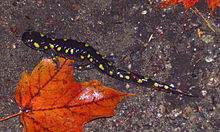
Back ফুটুকী জেঠী Assamese Ambystoma maculatum Bulgarian Sourd brizhellek Breton Ambystoma maculatum Catalan Ambystoma maculatum CEB Flecken-Querzahnmolch German Ambystoma maculatum Spanish Ambystoma maculatum Basque Täpläsalamanteri Finnish Salamandre maculée French
| Spotted salamander | |
|---|---|

| |
| Scientific classification | |
| Domain: | Eukaryota |
| Kingdom: | Animalia |
| Phylum: | Chordata |
| Class: | Amphibia |
| Order: | Urodela |
| Family: | Ambystomatidae |
| Genus: | Ambystoma |
| Species: | A. maculatum
|
| Binomial name | |
| Ambystoma maculatum (Shaw, 1802)
| |

| |
| Range of A. maculatum | |
| Synonyms[2] | |
| |
The spotted salamander or yellow-spotted salamander (Ambystoma maculatum) is a mole salamander[2] common in eastern United States and Canada.[1] It is the state amphibian of Ohio and South Carolina. The species ranges from Nova Scotia, to Lake Superior, to southern Georgia and Texas.[3] Its embryos have been found to have symbiotic algae living in and around them,[4] the only known example of vertebrate cells hosting an endosymbiont microbe (unless mitochondria are considered).[5][6]
- ^ a b IUCN SSC Amphibian Specialist Group. (2022). "Ambystoma maculatum". IUCN Red List of Threatened Species. 2022: e.T59064A193224401. doi:10.2305/IUCN.UK.2022-1.RLTS.T59064A193224401.en. Retrieved 25 April 2023.
- ^ a b Cite error: The named reference
Frostwas invoked but never defined (see the help page). - ^ "ADW: Ambystoma maculatum". Animaldiversity.ummz.umich.edu. Retrieved 2012-08-15.
- ^ Petherick, Anna (30 July 2010). "A solar salamander". Nature. doi:10.1038/news.2010.384.
- ^ Frazer, Jennifer (May 18, 2018). "Algae Living inside Salamanders Aren't Happy about the Situation". Scientific American Blog Network.
- ^ Burns, John A; Zhang, Huanjia; Hill, Elizabeth; Kim, Eunsoo; Kerney, Ryan (2 May 2017). "Transcriptome analysis illuminates the nature of the intracellular interaction in a vertebrate-algal symbiosis". eLife. 6: e22054. doi:10.7554/eLife.22054. PMC 5413350. PMID 28462779.
